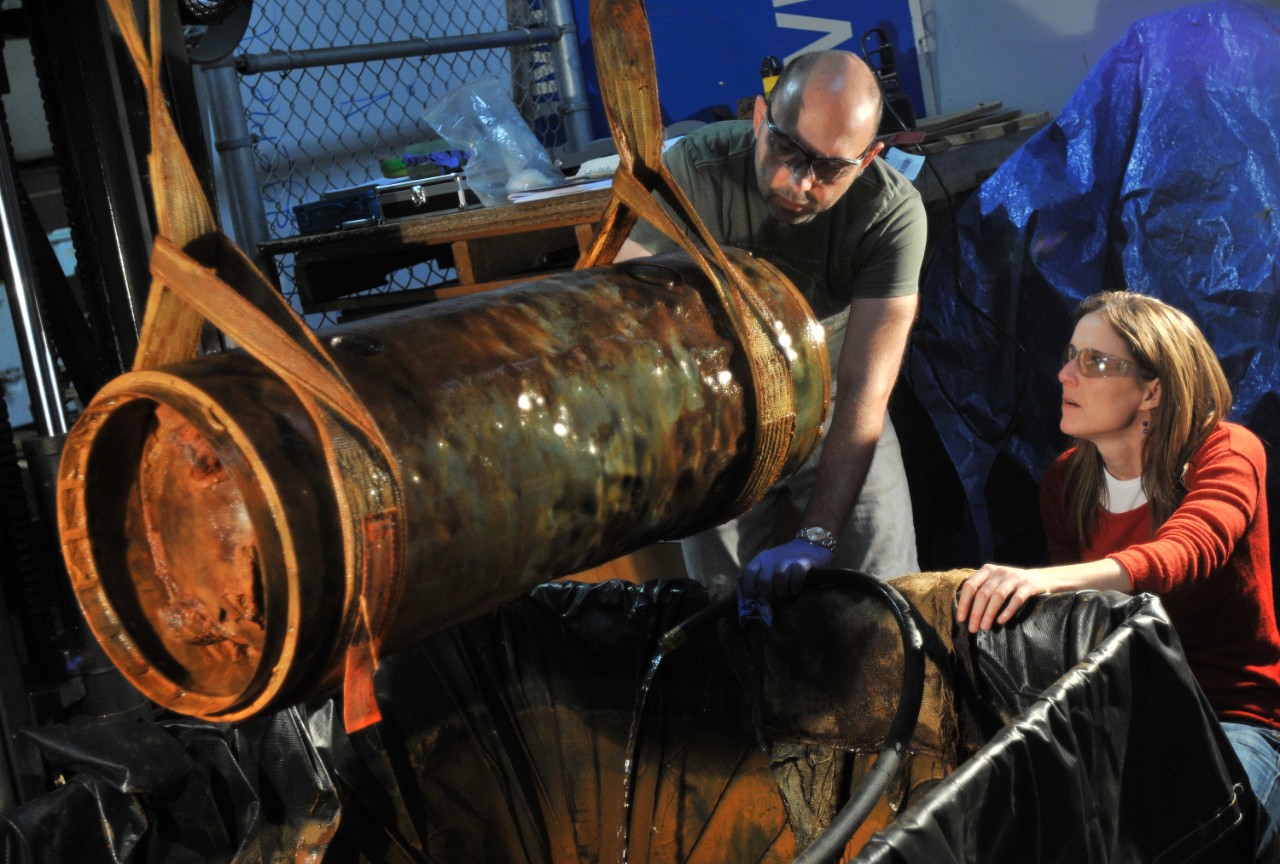
Story Number: NNS130523-32Release Date: 5/23/2013 11:03:00 PM
By Elisha Gamboa
SAN DIEGO (NNS) -- Space and Naval warfare Systems Center Pacific (SSC Pacific) has discovered and recovered one of the first self-propelled torpedoes developed and used by the U.S. Navy, known as the Howell torpedo.
Primarily the work of Lt. Cmdr. John A. Howell, the Howell torpedo was developed between 1870 and 1889. The Howell torpedo was an 11-foot long brass torpedo, driven by a 132-pound flywheel spun to 10,000 rpm prior to launch. It had a range of 400 yards, a speed of 25 knots, and a warhead filled with 100 pounds of gun cotton.
"It was the first torpedo that could be released into the ocean and follow a track. Considering that it was made before electricity was provided to U.S. households, it was pretty sophisticated for its time," said Christian Harris, operations supervisor for the SSC Pacific Biosciences Division.
The Howell torpedo was used by U.S. Navy (USN) battleships and torpedo boats until 1898, when it was replaced by the Whitehead.
"There were only 50 Howell torpedoes made," said Braden Duryee, operations supervisor for the SSC Pacific Biosciences Division. Only two other such torpedoes are known to exist today.
The Howell torpedo recovered by SSC Pacific, is stamped "USN No. 24." The Naval Undersea Museum in Keyport, Wash. has one on display, and the Naval War College Museum in Newport R.I. holds the other.
SSC Pacific discovered the Howell torpedo in March 2013, off the San Diego coast, near Hotel Del Coronado, during a mine-hunting training exercise with Navy dolphins.
"Dolphins naturally possess the most sophisticated sonar known to man. They can detect mines and other potentially dangerous objects on the ocean floor that are acoustically difficult targets to detect," explained Duryee.
The Navy has an entire program dedicated to studying and training marine mammals, called the Navy Marine Mammal Program (NMMP). The development, training, veterinary care and research facility that supports NMMP is centered in the Biosciences Division at SSC Pacific.
With the NMMP, the Navy trains dolphins to find and mark the location of underwater objects. Some of the objects the animals find, such as non-explosive Navy training mines, are expensive to replace. Others could present a danger to Navy personnel and vessels. In this case, the object found was an important piece of naval history.
"The animals are very good at their job. We were just doing our daily training exercises with the animals, when one marked an object on the sea floor. About a week later, another animal marked the same object," said Duryee.
During training and the actual hunting of mines, a dolphin waits to receive a cue from its handler before it begins to search a specific area. Once the dolphin completes its search, it reports back to its handler, giving one response if a target object is detected, and a different response if no target object is detected.
This time the dolphin detected a mine-like target; the handler sent the dolphin to mark the location of the object so that Navy divers could recover it.
At first, the recovery team thought the object was an old tail section off an aerial drop mine, but once the object was recovered, it was obvious that the object was something completely different.
"It was apparent in the first 15 minutes that this was something that was significant and really old," said Harris. "Realizing that we were the first people to touch it or be around it in over 125 years was really exciting."
After thorough research, the team discovered that the object was in fact a 130-year-old Howell torpedo. After the noteworthy discovery, SSC Pacific moved quickly to preserve this part of naval history.
"The torpedo was in remarkably pristine shape, so to preserve it, Braden Duryee had the idea to submerge it into a tank of water to prevent it from breaking down in the surrounding oxygen," said Harris. "Later on, experts confirmed that Braden was correct."
SSC Pacific will continue to preserve the torpedo until it can be shipped by air to the Naval History and Heritage Command, located at the Washington Navy Yard. The Naval History and Heritage Command is an Echelon II command responsible for the preservation, analysis, and dissemination of U.S. Naval history and heritage for present and future generations.
For more information, visit www.navy.mil, www.facebook.com/usnavy, or www.twitter.com/usnavy.
For more news from Space and Naval Warfare Systems Command, visit www.navy.mil/local/spawar/.
Read more stories on the Howell Torpedo here:


